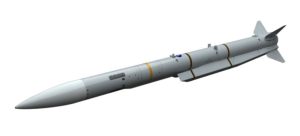In 1902, Britain and Japan formed an alliance in preparation for the expansion of the Russian Empire in Eurasia. One hundred and twenty years later, history may be rhyming, only with China at the forefront of their minds this time around.
As part of its budget request for fiscal year 2023, Japan’s Ministry of Defense has requested 300 million yen ($2.1 million) to push ahead with the co-development of a Joint New Air-to-Air Missile (JNAAM) with the United Kingdom.
The ministry also asked for a whopping 143.2 billion yen ($10 billion) to move ahead with its next-generation fighter program in partnership with the U.K., as The Diplomat reported on August 31. It plans to start a basic design of the future fighter’s fuselage from next fiscal year.
This budget request represents yet another deepening of security and defense cooperation between the two nations.
Britain has overseas territories in the Indo-Pacific such as Diego Garcia Island in the Indian Ocean and the Pitcairn Islands in the South Pacific, with more than 1.7 million British citizens living across the region. The British aircraft carrier the Queen Elizabeth made its first port call in Japan in September 2021, aiming to showcase the two countries’ defense cooperation as well as signaling a strong deterrent to China.
Liz Truss, Britain’s new prime minister, is highly likely to upgrade further the status of the bilateral partnership with Japan to the level of quasi-allies. She had signed the Japan-U.K. Comprehensive Economic Partnership Agreement (EPA) in 2020 and requested to join the Comprehensive and Progressive Agreement for Trans-Pacific Partnership in 2021 as the nation’s international trade secretary, in a push to expand post-Brexit trade with the Asia-Pacific region. She tweeted in October 2020 that the Japan-U.K. bilateral trade deal was “historic” and that it would “draw two democratic island nations closer together.” Meanwhile, Truss has taken a tough stance on both Russia and China.
In a congratulatory message to Truss on September 6, Japan’s Prime Minister Kishida Fumio expressed hope that the pair will work together “to further deepen the Japan-U.K. relationship as global strategic partners that share fundamental values.”
The funding request of 300 million yen for the JNAAM during fiscal year 2023 is for preparation costs related to the performance evaluation testing of the new missile’s seeker, an official at the Japanese defense ministry’s Acquisition, Technology, and Logistics Agency told The Diplomat on September 7.
The JNAAM program is Tokyo’s first defense equipment project with a foreign partner other than the United States. The joint research began in 2014 and transitioned to a prototype stage in fiscal year 2018. The project is expected to finish trial production of the prototype during the current fiscal year 2022 and scheduled to conclude by the end of fiscal year 2023, which is March 2024 in Japan, according to the official.
The two nations plan to integrate the JNAAM with their respective Lockheed Martin F-35 Lightning II multirole fighter aircraft fleets. The U.K. missile technologies included in the program relate to Meteor, MBDA’s beyond visual range air-to-air missile (BVRAAM).
On the Japanese side, the defense ministry is looking to integrate advanced radio frequency seeker technologies developed by Mitsubishi Electric Corporation for the AAM4B missile, or medium-range active radar homing air-to-air missile, with the aim of enhancing the accuracy and performance of the BVRAAM and supporting the development of the JNAAM.
Japan-U.K. cooperation has expanded with the co-development of weapons systems, such as the jet engine and sensor for their next-generation fighters. In developing a common fuselage for their new fighter jets, Italy is also being considered as an additional co-development partner, defense officials said.
The partnership could boost Japan’s defense-related exports in the future, benefiting a domestically dependent industry where business has been sluggish. The Japanese government reportedly plans to allow exports of fighter jets, missiles, and other arms to 12 countries, including India and Australia, as well as some European and Southeast Asian nations.

































